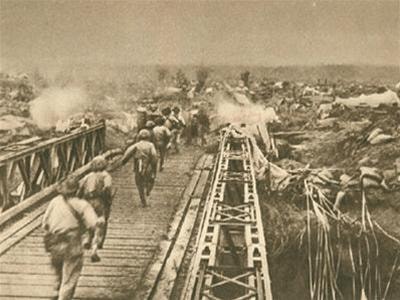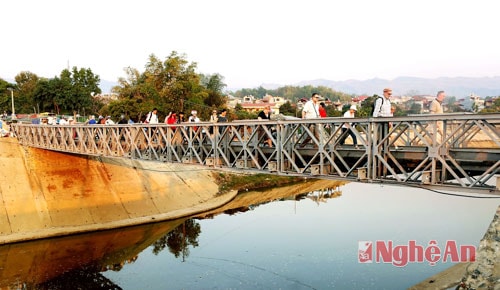Muong Thanh Bridge - the "historical bridge of march"
(Baonghean.vn) -Muong Thanh Bridge, called “Prenley” by the French army, is a bridge across the Nam Rom River, located about 300 meters from the current intersection of Highway 279. The bridge is a military structure located in the central subdivision of the Dien Bien Phu stronghold complex.
Implementing the Nava plan, on November 20, 1953, Na Varre sent 150 planes carrying 4,000 paratroopers to Dien Bien Phu. The French press boasted about the “Parachute Rain on Dien Bien Phu” and General Nava declared: “I will take the initiative, I will keep the initiative”. Nava also wrote a witty letter to French soldiers: “Victory! Must be determined to win! But victory is a woman who only loves you when you know how to conquer”.
 |
| Our army crossed Muong Thanh bridge and entered the center of Dien Bien Phu. Photo archive |
Then Nava built Dien Bien Phu into the strongest stronghold group in Indochina, consisting of three sub-regions, eight clusters and 49 strongholds, each cluster was named after a beautiful young woman of France and each stronghold had trenches connected to command bunkers, sleeping bunkers, ammunition bunkers, and firepower to support 50 heavy artillery pieces of 155 mm and 105 mm. Thus, on average, each stronghold was equipped with 4 heavy machine guns, 45 submachine guns, 9 medium machine guns, 9 grenade launchers, 2 60 mm mortars, 1 57 mm recoilless rifle and at important strongholds were equipped with flamethrowers and infrared guns for night shooting.
At Dien Bien Phu, France had 2 airports with 14 permanent aircraft, 7 fighter planes, 6 reconnaissance planes, 1 helicopter and also 10 18-ton tanks, 120 transport vehicles. The number of French troops at Dien Bien Phu was up to 16,200, they boasted about the strongest defense system, even in World War II, the French army had never built "a field defense system as strong as in Dien Bien Phu" and Dien Bien Phu was considered an impregnable fortress, General De Castries had leaflets scattered everywhere challenging our army to attack.
Because the terrain of Dien Bien Phu is a wide basin, surrounded by high mountains, in the central battlefield there is the Nam Rom River flowing through, dividing the central sector into two sides, the left and right banks, so communication from the central command post with the strongholds on the eastern and northeastern hills encountered many difficulties. To solve these difficulties, the French ordered the construction of the Muong Thanh Bridge across the Nam Rom River. The Muong Thanh Iron Bridge is a makeshift bridge that was prefabricated and transported from France to be assembled in Dien Bien. The entire bridge is 40 m long and 5 m wide. The two sides of the bridge are simple supporting iron bars, there is no central axis, the bridge floor is paved with wood, below are iron beams that are firmly connected together to ensure a load of 8-15 tons.
To protect this vital bridge, the French army arranged strongholds 509, 508 and 507 on the eastern end of the bridge, and on the western end they arranged a 4-barreled machine gun nest to guard against the enemy attacking across the bridge to attack the central command post. With such a force arrangement, General De Castries hoped to hold the bridge, holding the gateway to supply the high points in the east and northeast of the Dien Bien Phu stronghold. Before the war broke out, Muong Thanh bridge was the route for transporting raw materials, ammunition, and barbed wire to serve the construction of defensive strongholds in the east and the northern sub-region. When our army destroyed the Him Lam resistance center, the French army also used this bridge for ambulances to pick up prisoners at the Him Lam resistance center and from here French tanks departed to reinforce the A1 base on the night of March 31, 1954. Two of those tanks were shot down by our army, one burned and the other fled back to the center in the early morning of April 1, 1954.
 |
| French tourists cross Muong Thanh bridge. |
In the general offensive to destroy all the eastern high points at 4:00 a.m. on May 7, 1954, our army destroyed the entire A1 stronghold. At 2:00 p.m., Regiment 209 and Division 312 launched an attack on stronghold 597 at the head of Muong Thanh bridge. The enemy at stronghold 507 raised the white flag and surrendered. Taking advantage of the victory, Division 312 continued to attack and destroy two strongholds 508 and 509 on the left bank of Nam Rom River. At these two strongholds, the enemy resisted weakly and was quickly destroyed. From the East, Regiment 209 advanced straight into the central area of Muong Thanh, together with Regiment 98 and Regiment 174, approaching the central area. In the West, Regiment 36 advanced into the last strongholds to shield the enemy's command post. Regiment 88 opened a path through the airport and advanced straight into GONO's last lair. Wherever our army fought, the enemy's white flags appeared. Many enemy groups from strongholds and trenches came out one after another to surrender their weapons.
At 17:15, a wing of the 312th Division advanced close to the enemy's command post. Platoon leader Chu Ba The discovered a white flag on General De Castries' bunker. Company leader Ta Quoc Luat led the assault team straight into the central area. On the way to attack, they were fired upon by the 4-barreled heavy machine gun protecting Muong Thanh bridge, blocking our attack. The soldiers, regardless of their sacrifices, bravely fought to extinguish the 4-barreled heavy machine gun fire and quickly advanced through the dense bullets. Company leader Ta Quoc Luat and the soldiers in the assault team crossed Muong Thanh bridge and went straight into the enemy's command post, capturing General De Castries and the entire General Staff of the Dien Bien Phu stronghold. At exactly 17:30 on May 7, 1954, the "Determination to Fight - Determination to Win" flag of our army fluttered on the roof of General De Castries' bunker, ending the victory of the historic Dien Bien Phu campaign. This was the greatest victory in the long resistance war against French colonialism and American interventionists, and also the most glorious victory in the history of the Vietnamese people's resistance against foreign invaders.
Muong Thanh Bridge is a historical bridge, a relic that has been restored and protected to serve tourists. After 60 years, Muong Thanh Bridge is still kept intact as when it was first built and will forever be a "historical bridge".
Tran Duy Ngoan






